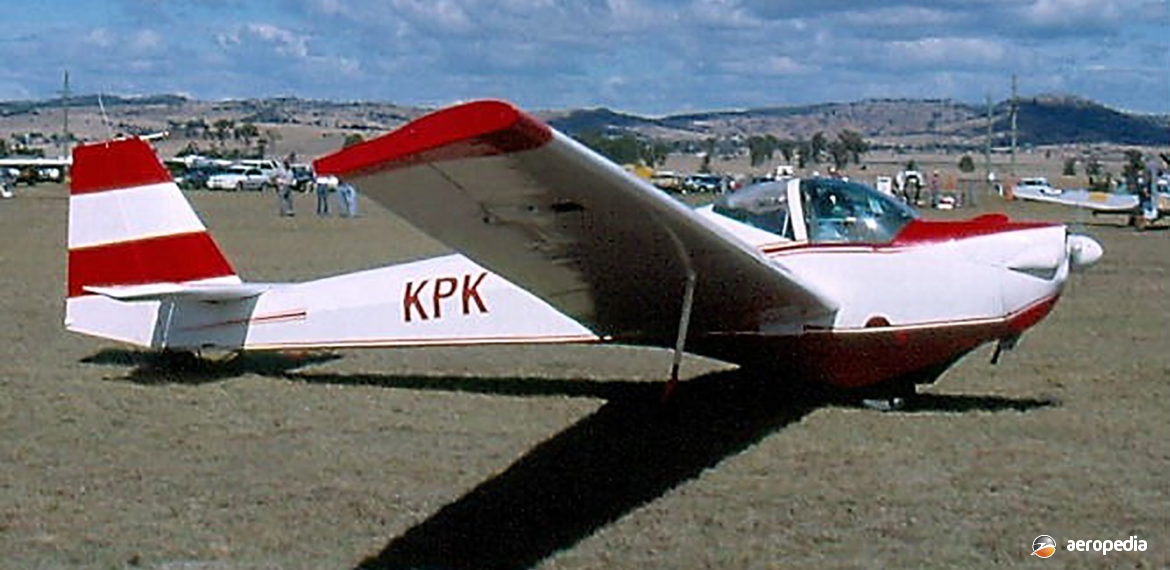Photograph:
Scheibe SF-25 Falke VH-KPK (c/n AE-2008-061) at Watts Bridge, QLD in August 2003 (David C Eyre)
Country of origin:
United Kingdom
Description:
Two-seat touring monoplane/powered glider
Power Plant:
One 36 kw (48 hp) Rollason conversion of the 1600 cc Volkswagen four-cylinder horizontally-opposed air-cooled engine
Specifications:
- [T-61E]
- Wingspan: 15.3 m (50 ft 2½ in)
- Length: 7.6 m (24 ft 9 in)
- Wing area: 17.5 m² (188 sq ft)
- Max speed: 148 km/h (92 mph)
- Stalling speed: 61 km/h (38 mph)
- Max sink rate: 60 m/min (197 m/min)
- Empty weight: 375 kg (827 lb)
- Loaded weight: 612 kg (1,349 lb)
- Max wing loading: 33.63 kg/m² (6.88 lb/sq ft)
- Payload: 195 kg (430 lb)
History:
Designed by Egon Scheibe, this series of self-launching gliders was introduced in 1968 by the German firm, Scheibe, which commenced production of a side-by-side two-seat dual-control training version of the SF-24A Motorspatz. A number of variants was produced, including the SF-25A with a 19 kw (26 hp) Hirth F-10A engine, and the SF-25B with a 34 kw (45 hp) Stark Stamo MS1500 engine. The latter had larger tail surfaces, improved fuselage lines, and cabin glazing. The SF-25C and SF-25C-S were improved versions fitted with the more powerful 45 kw (60 hp) Limbach SL1700 EA engine. As well as a domed canopy, enlarged fin, and smaller rudder with increased sweep, they also had an optional twin-wheel main undercarriage with streamlined wheel fairings. About 200 examples of the SF-25C were built by Scheibe, and 50 examples by Sportavia.
In 1970 licence production of the Model SF-25B was commenced in the United Kingdom by Slingsby Sailplanes Ltd as the Type 61A Falke fitted with a Stamo 1500/1 engine, which was a conversion of the 1500 cc Volkswagen engine. Subsequent development led to the Type 61C Falke, fitted with the Stamo MS1500/2 engine with an electric starter. One British-built machine was experimentally fitted with a two-cylinder Franklin 2A-120-A engine, and this became known as the Type 61B.
The type was used in the United Kingdom for some years by the Air Training Corps for student training as the Venture T Mk 2, 40 examples being supplied. A specific model was developed for that service and became known as the Vickers-Slingsby T-61E. An improved version of the previous models, it had a glass-fibre main spar encased in plywood, thus reducing the empty weight and increasing the payload. A number of other components were also built of glass-fibre.
A number of examples have been imported to Australasia since the 1960s. Examples include German-built models: Scheibe 25B VH-HNM (c/n 46190), VH-HNO (c/n 46204), VH-IKB (c/n 46208), and VH-HNP (c/n 46214) and a Scheibe SF-25C-2000 two-seater with a 60 kw (80 hp) Limbach engine. Most are registered under Australian Gliding Federation rules Other examples include SF-25Cs VH-GXM (c/n 4474), VH-GPM (c/n 4492), VH-GLA (c/n 44175), VH-GQX (c/n 44179), VH-GUA (c/n 44183), VH-GQW (c/n 44250), VH-KPK (c/n 44182), VH-KPT (c/n 46240), VH-FQW (c/n 44250), VH-FQX (c/n 44179), VH-GLA (c/n 44175) and VH-GLC (c/n 4454).
Examples of the British-built T-61C Falke series registered in Australia have included VH-GSS (c/n 1752), VH-GBH (c/n 1769), VH-XJX (c/n 1744); and T-61Cs registered in New Zealand include ZK-DOI which later became ZK-GOD (c/n 1775), the latter being operated by the Auckland Branch of the Air Cadet League from March 1990.

